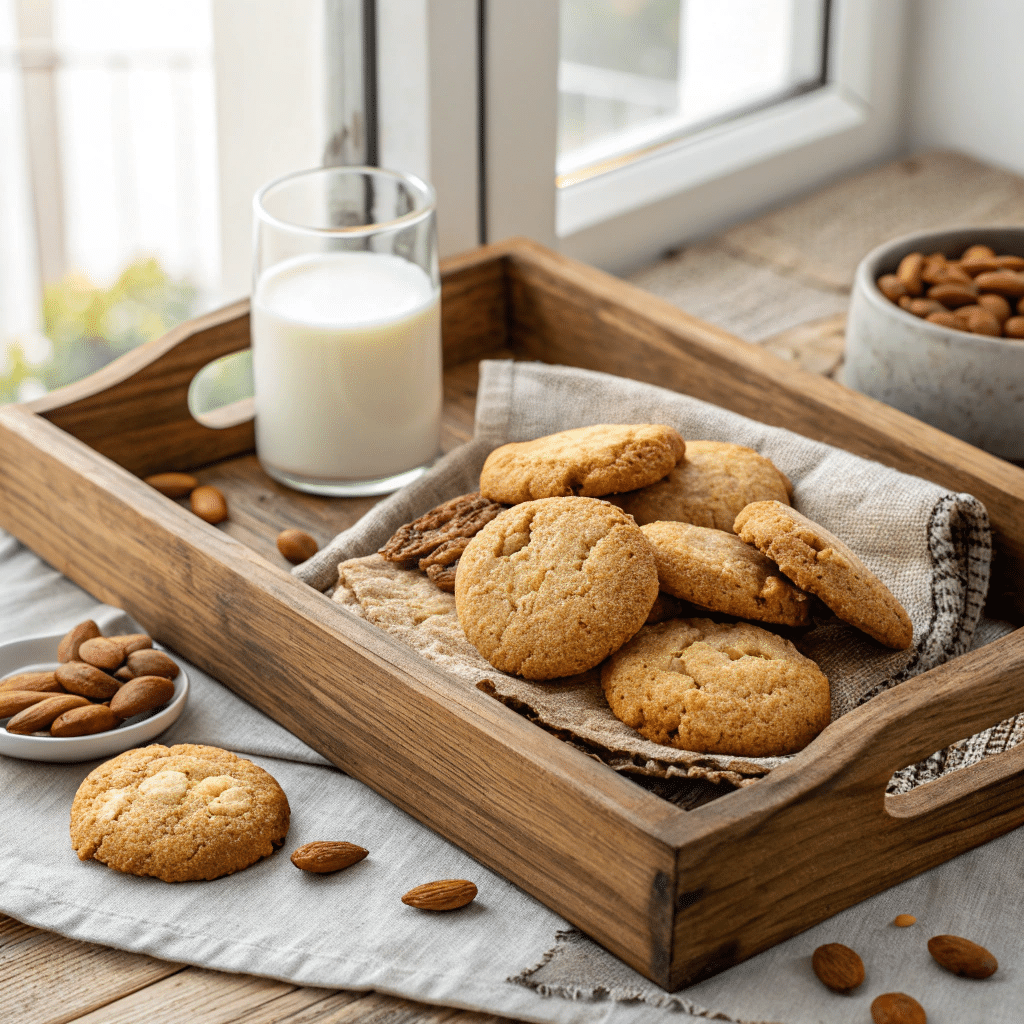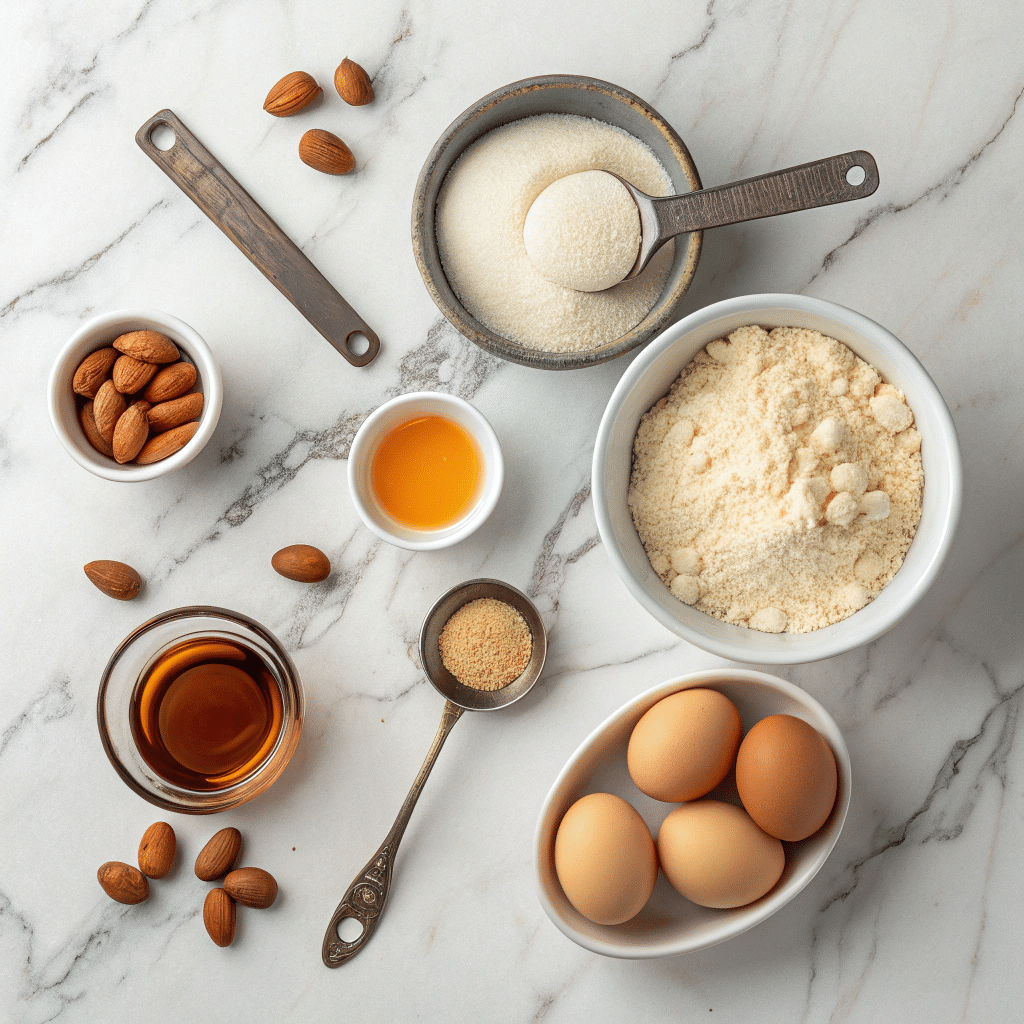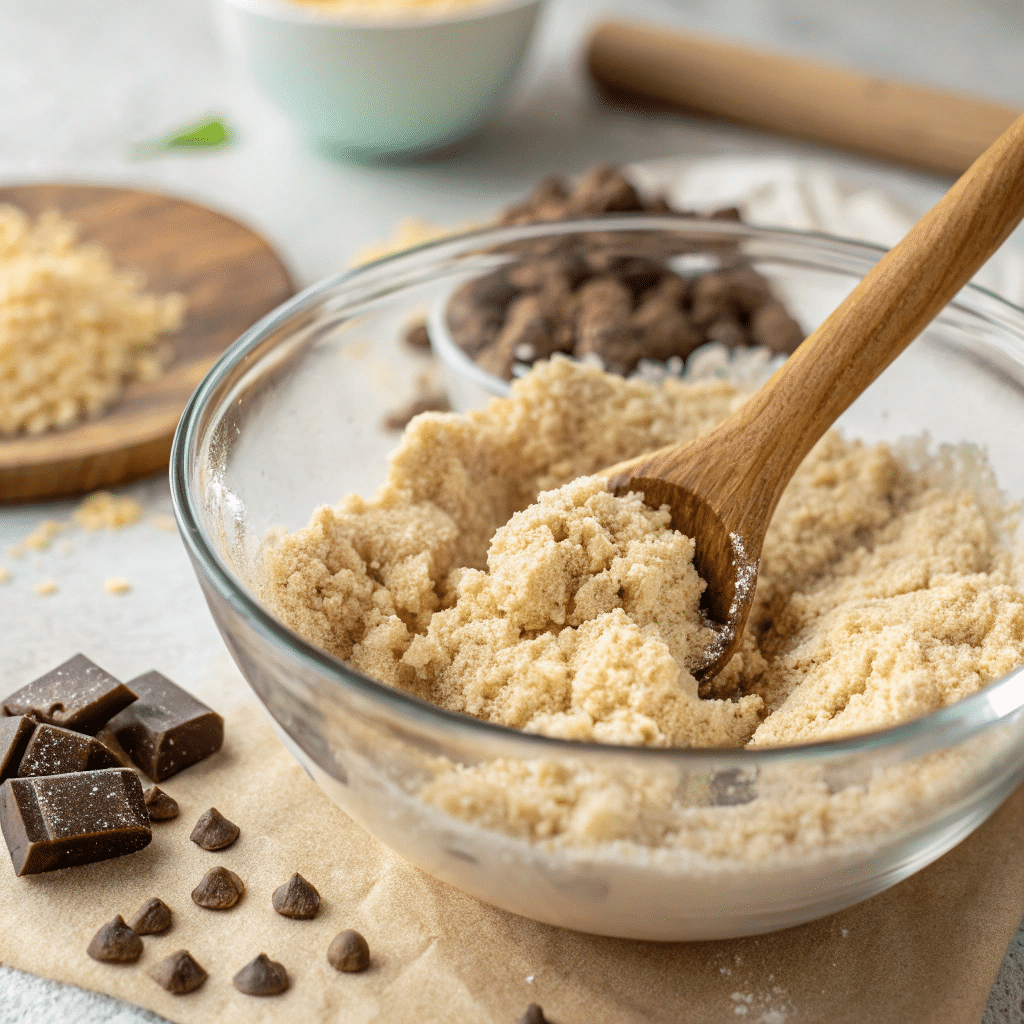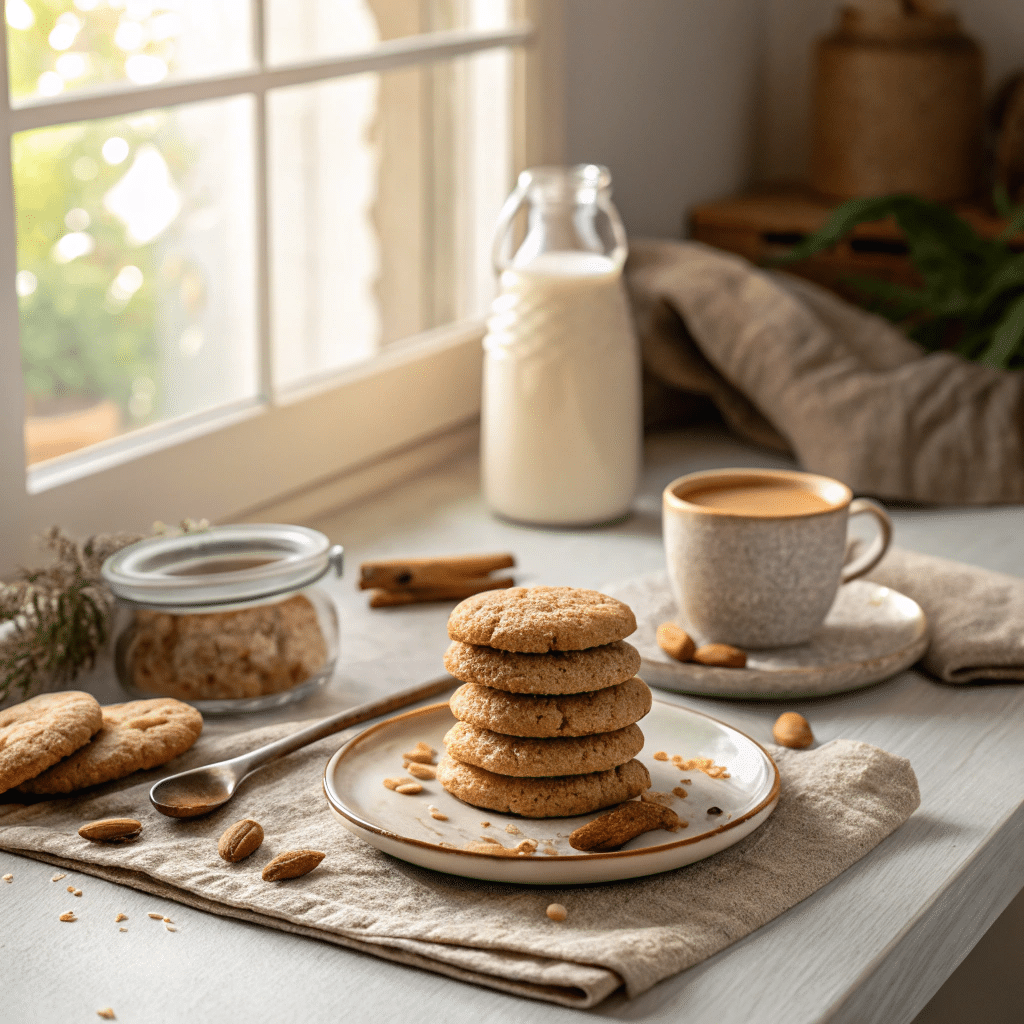Almond flour cookies are having a delicious moment and for good reason. Whether you’re gluten-free or just love that rich, nutty flavor, these cookies deliver big satisfaction in a small, wholesome bite. In this article, we’ll break down everything you need to know: from my own baking journey with almond flour (including a few flops!) to the top tricks for structure, flavor, and texture. If your almond flour cookies have ever crumbled into dust or come out greasy, I’ve been there and I’ll show you how to fix it. Let’s get baking with confidence!

Table of Contents
Table of Contents
Why I Fell in Love with Almond Flour Cookies
The first time I tried baking with almond flour, I was full of optimism and ended up with a tray of greasy, crumbly mess that barely resembled cookies. They stuck to the tray, fell apart in my hands, and taught me a lesson: almond flour plays by its own rules. But that flop sparked something. I kept trying, experimenting with texture, binders, and sweetness, and finally created a recipe so good, it’s now part of our weekly rotation.
These days, almond flour cookies are more than just an occasional treat they’re my go-to when I want something sweet, quick, and just a bit better-for-you. The nutty richness of almond flour gives cookies a naturally tender texture and a flavor that’s way more exciting than your average sugar cookie. And since almond flour is gluten-free and low in carbs, it’s ideal for friends and family with different dietary needs.
What surprised me most is how versatile these cookies can be. From chewy chocolate chip versions to lighter lemon-zest ones, almond flour plays well with many flavors. And once you learn how to work with its moisture-rich, gluten-free structure, you’ll understand exactly why almond flour is good for cookies.
If you’ve ever had trouble with cookies spreading too much or breaking apart, you’re not alone. But that’s why I’m here to share everything I’ve learned, from what holds them together to how to make them taste just like classic favorites. Along the way, I’ll be drawing on tricks similar to the chocolate chip oat bars over at QuickMealRecipe and tips from no-egg cookies that you’ll find useful here too.
Baking with almond flour isn’t just about changing flour. It’s about shifting how you think about texture, moisture, and flavor. Once you do, the results are golden-edged, soft-centered cookies that taste indulgent but feel wholesome like the ones we love from Quick Almond Biscuits or 5-ingredient cookie bites.
PrintAlmond Flour Cookies: Chewy, Nutty & Naturally Gluten-Free
- Total Time: 20 mins
- Yield: 12 cookies 1x
Description
Chewy, naturally gluten-free almond flour cookies made with simple ingredients and full of rich, nutty flavor.
Ingredients
2 cups almond flour
1/4 cup maple syrup
1 egg (or flax egg)
1/2 tsp baking soda
1/4 tsp salt
1 tsp vanilla extract
1/4 cup chocolate chips (optional)
Instructions
1. Preheat oven to 350°F (175°C) and line a baking sheet.
2. Mix almond flour, baking soda, and salt in a bowl.
3. In another bowl, whisk egg, maple syrup, and vanilla.
4. Combine wet and dry ingredients until dough forms.
5. Fold in chocolate chips if using.
6. Scoop small dough balls onto tray, leaving space.
7. Bake 9–11 minutes until golden on edges.
8. Cool fully on tray to set.
Notes
Chill dough for 20 minutes for better shape.
Store in airtight container for up to 5 days.
Swap maple syrup for honey or agave if desired.
- Prep Time: 10 mins
- Cook Time: 10 mins
- Category: Dessert
- Method: Baking
- Cuisine: American
Nutrition
- Serving Size: 1 cookie
- Calories: 110
- Sugar: 5g
- Sodium: 40mg
- Fat: 9g
- Saturated Fat: 1g
- Unsaturated Fat: 7g
- Trans Fat: 0g
- Carbohydrates: 6g
- Fiber: 1.5g
- Protein: 3g
- Cholesterol: 15mg

Baking Success with Almond Flour
Baking with almond flour is a bit like learning to drive a stick shift there’s a slight learning curve, but once it clicks, you’ll never look back. The biggest adjustment? Almond flour doesn’t behave like all-purpose flour. It’s made from finely ground almonds with no gluten and more fat, which makes cookies rich and tender but also a little delicate if you don’t get the ratios right.
Let’s start with structure. Since almond flour has no gluten, it needs help holding everything together. The trick? Use eggs (or flax eggs if you’re going vegan) for binding. They provide structure, lift, and moisture. Many bakers also add a tablespoon of coconut flour or tapioca starch to help absorb some of the fat and moisture, giving the dough a sturdier base without losing that soft bite.
Sweetness matters too. Because almond flour has a naturally nutty, slightly sweet flavor, you can reduce your added sugar. That’s why recipes like these soft keto chocolate chip cookies don’t taste bland even without traditional sugar.
Another tip? Chill your dough. Almond flour cookies spread more than regular ones, so 20–30 minutes in the fridge before baking helps firm things up. You’ll also want to scoop smaller portions onto your tray and leave space these cookies like to spread and crisp up at the edges.
Want to dial up the flavor? Toast your almond flour for 3–4 minutes on low heat before using. It adds a lovely depth that pairs perfectly with vanilla, cinnamon, or dark chocolate chunks. It’s a trick I use often in my almond oat clusters, and it makes a big difference.
Above all, the most important step is trusting the process. Your batter may look looser than traditional cookie dough. Don’t panic. Spoon it out, let it chill, and bake until golden on the edges and set in the middle. Once cooled, they’ll firm up beautifully something I learned the hard way after tossing a batch too early (rookie mistake).
If you’ve ever struggled with cookies falling apart or spreading into thin puddles, you’ll want to keep these tricks in your apron pocket. Combine them with a reliable recipe like this one-bowl almond cookie mix, and you’ll be golden literally.

Why Do Almond Flour Cookies Fall Apart?
If you’ve baked almond flour cookies only to watch them crumble in your hands, you’re not alone. The number one complaint I hear is that almond flour cookies fall apart after baking. It’s frustrating when the flavor is spot on but the cookie just can’t hold its shape. The good news is, this is fixable.
The issue starts with structure. Almond flour is gluten-free, which means there’s nothing naturally holding the cookie together. Gluten acts like a web that keeps traditional cookie dough strong. Without it, your almond flour cookies need help in the form of binders. That’s why using eggs is so important. One large egg in a small batch can make all the difference. For vegan versions, ground flaxseed mixed with water works too, but it needs extra resting time before baking.
Another reason cookies fall apart is too little moisture. Ironically, almond flour is high in natural fats, but it still needs the right amount of liquid to bind properly. A splash of almond milk, a tablespoon of honey, or even a bit of nut butter can help bring everything together. Always mix thoroughly and give the dough time to rest. That resting period allows the ingredients to hydrate and stick.
It’s also important to avoid overbaking. Almond flour cookies can look pale and soft even when they’re ready. If you wait until they look browned all over, you may end up drying them out. That’s when crumbling becomes a real issue. Take them out once the edges are golden and let them finish setting on the tray. As they cool, they firm up into the perfect chewy texture.
When in doubt, don’t skip chilling the dough. It firms up the fat and helps prevent cookies from spreading too much. I use this step in nearly every almond flour recipe, including my chill-and-bake cinnamon cookies. It keeps the shape tight and improves the final bite.
Still struggling? Try a tested recipe like these almond chocolate delights. You’ll notice a balance of wet and dry ingredients that’s hard to achieve without a bit of practice. Once you’ve nailed it, the results are consistent, tender cookies that don’t fall apart at first touch.
With the right method and a bit of patience, your almond flour cookies will go from fragile to fantastic. In the next section, we’ll cover ingredient variations, flavor pairings, and a few smart add-ins that make your cookies shine.
Flavor Twists and Almond Flour Cookie Variations
Once you’ve mastered the base recipe, almond flour cookies become a blank canvas. Their nutty, mild flavor makes them perfect for customization. Whether you want a classic treat or something a little bold, almond flour cookies can handle it all. The secret is choosing ingredients that complement almond flour’s texture and natural richness.
Chocolate chips are an easy starting point. A handful of dark or semi-sweet chips balances the earthy flavor of almond flour and adds texture. You can also swap in chopped nuts, shredded coconut, or dried fruit. These mix-ins add chewiness and help give the cookies structure. For something lighter, try lemon zest and a splash of vanilla. That combination turns almond flour cookies into a perfect spring dessert.
Spices work beautifully too. Cinnamon, cardamom, or even a pinch of ginger can elevate the dough without overpowering it. If you’re feeling adventurous, stir in tahini or almond butter. These add moisture and depth while keeping the cookie soft. Just reduce the added oil or butter slightly to compensate.
You can also experiment with sweeteners. Maple syrup or coconut sugar brings out the warm tones in almond flour cookies. For a low-carb version, erythritol or monk fruit sweetener works well. Just be aware that different sweeteners affect texture and spread, so small test batches are helpful.
If you’re making cookies for special occasions, go fancy. Drizzle melted dark chocolate on top or sandwich two cookies with a cream cheese filling. These tweaks take almond flour cookies from simple to standout. For more ideas, check out these almond butter banana cookies or try something fun like Dubai pistachio chocolate bartes.
You can even make them part of breakfast. A few crushed almonds, some oats, and less sugar turn them into an easy morning snack. Pair with coffee, tea, or a smoothie, and they’ll fit right into your routine. My kids love them tucked into lunchboxes, and they’re sturdy enough to travel well.
No matter how you flavor them, almond flour cookies stay true to their charm. They’re rich, chewy, and naturally satisfying. Add-ins make them interesting, but it’s the texture that keeps you coming back.
Now that we’ve covered baking tips, structure solutions, and creative flavor options, let’s answer the most common questions about almond flour cookies.
FAQ: Almond Flour Cookies
Is almond flour good for cookies?
Yes, almond flour is excellent for cookies. It creates a soft, tender texture with a naturally rich flavor. Since almond flour is gluten-free, it gives cookies a slightly chewy bite without being dry. Many people love almond flour cookies for their lower carb content and wholesome ingredients. The nutty taste also pairs beautifully with vanilla, chocolate, or citrus flavors. If you want a gluten-free or grain-free cookie option, almond flour is a solid choice.
What is the trick to baking with almond flour?
The key to baking with almond flour is balance. Because almond flour lacks gluten, it needs a binder to hold cookies together. Eggs, flaxseed, or nut butter all help. Chilling the dough before baking also improves structure and prevents spreading. Don’t overbake—almond flour cookies may feel soft at first but firm up as they cool. For best results, measure ingredients carefully and avoid swapping almond flour directly for wheat flour in standard recipes.
Why do my almond flour cookies fall apart?
Cookies made with almond flour often fall apart due to lack of binding. Since there’s no gluten, the dough can be fragile unless you add something to help it hold. Eggs or flax eggs provide structure, while letting the cookies cool fully after baking gives them time to firm up. Another reason could be overbaking. Almond flour cookies continue to set outside the oven, so remove them when edges turn golden. Adding a tablespoon of coconut flour or starch can also help with texture and hold.
Conclusion: Almond Flour Cookies Made Simple
Baking almond flour cookies doesn’t need to be intimidating. Once you understand the structure, moisture, and flavor needs, you’ll unlock a world of cookies that are naturally gluten-free, satisfying, and full of rich, nutty taste. Whether you love them chewy with chocolate chips or light with lemon and vanilla, almond flour gives you the flexibility to experiment without compromising texture. With just a few smart tweaks and patience, even beginners can create cookies that hold together, taste amazing, and make everyone reach for seconds.
From learning why your almond flour cookies fall apart to how to customize them with spices or fillings, you’ve got everything you need to bake with confidence. So, tie on that apron, grab your almond flour, and get those cookies in the oven. If I can do it, you can too.
For more gluten-free treats, don’t miss these oatmeal almond thumbprints or the always reliable flourless chocolate cake recipe. Let’s keep the cookie love going.

